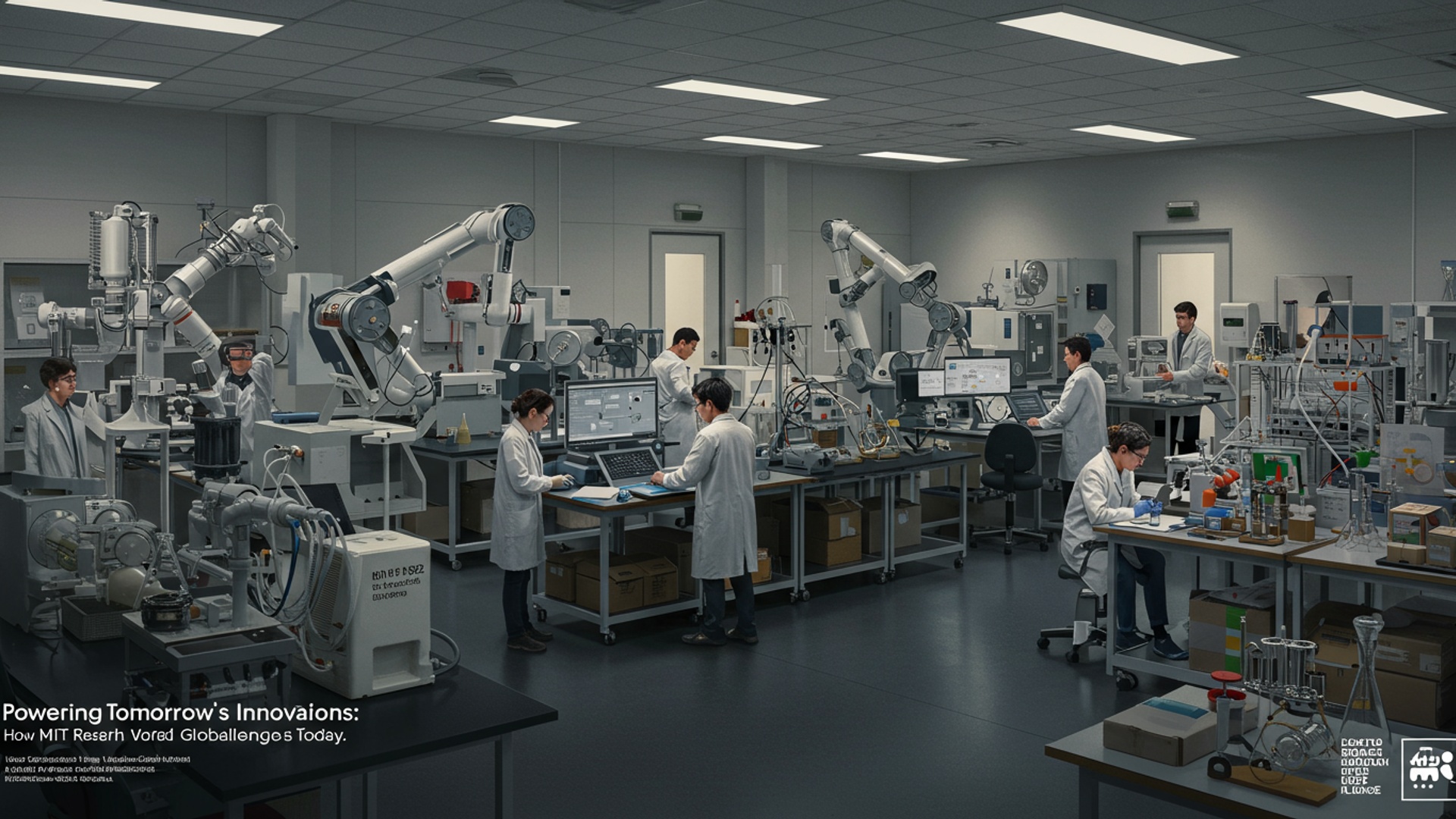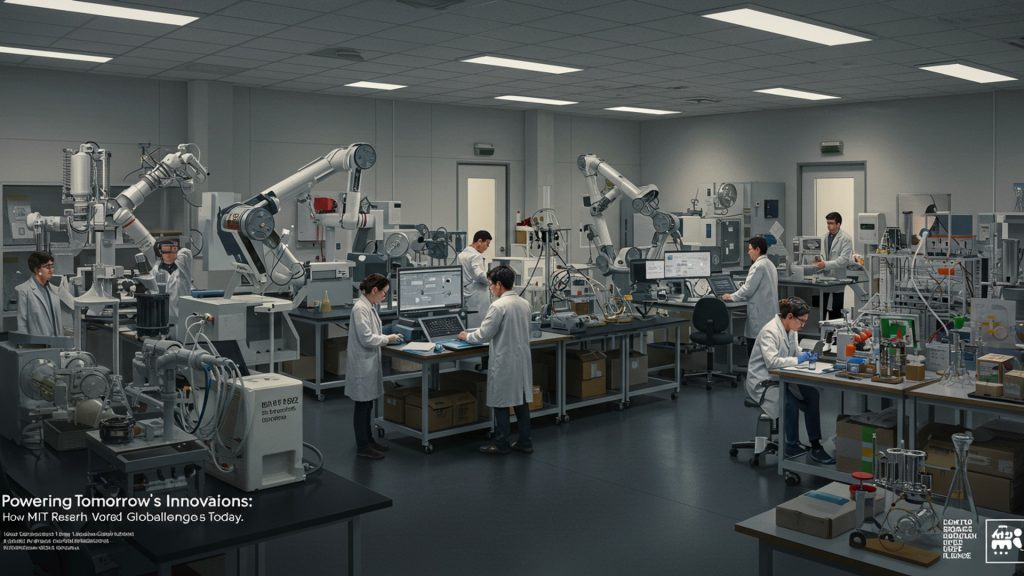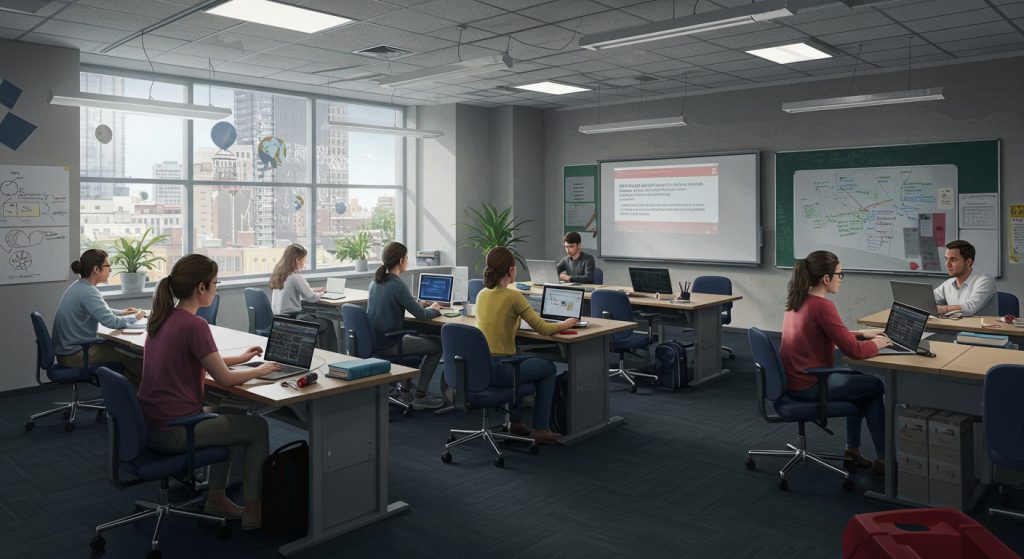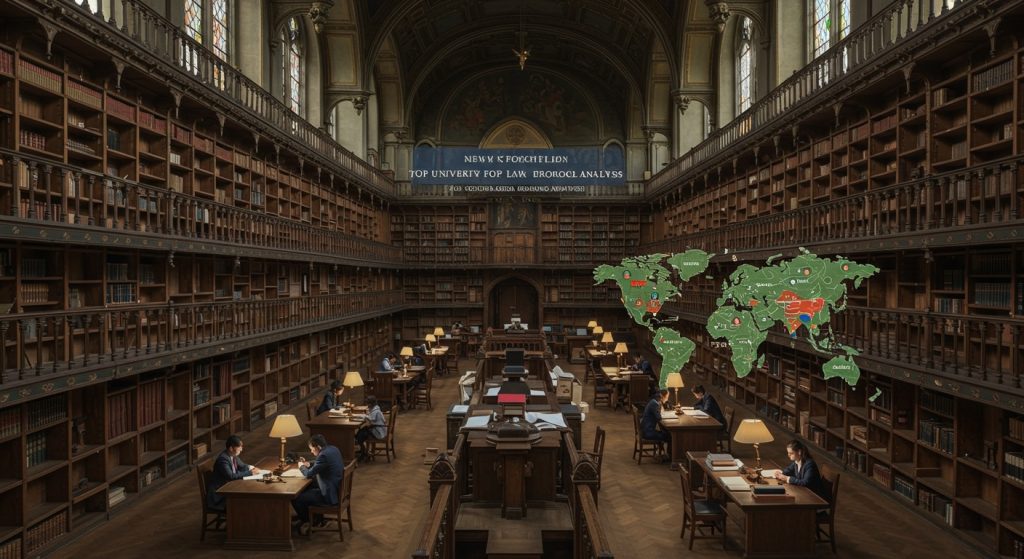As humanity navigates unprecedented global challenges, from climate change’s intensifying grip to the urgent need for sustainable resources and advanced healthcare, the Massachusetts Institute of Technology stands at the vanguard of groundbreaking innovation. Researchers at the Massachusetts Institute of Technology are not just conceptualizing; they are actively engineering scalable fusion energy solutions to redefine clean power, developing sophisticated AI models for predictive climate analytics and real-time medical diagnostics. pioneering novel materials for resilient infrastructure. This relentless pursuit of discovery across diverse scientific and engineering disciplines ensures that MIT’s laboratories are today incubating the very breakthroughs that will empower and secure tomorrow’s world, transforming complex problems into actionable, impactful solutions.

Tackling Climate Change with Groundbreaking Solutions
One of the biggest challenges facing our planet today is climate change. It’s a huge problem. thankfully, brilliant minds at the Massachusetts Institute of Technology are on the case, developing innovative solutions to help us build a more sustainable future. Their research isn’t just theory; it’s about creating real-world tools and technologies that can make a tangible difference.
For example, let’s talk about renewable energy storage. You know how solar panels only work when the sun is out. wind turbines need wind? That’s where energy storage comes in. We need ways to save excess energy generated during peak production times and release it when needed. Researchers at the Massachusetts Institute of Technology are exploring incredibly creative ways to do this, far beyond just better batteries.
- Long-Duration Energy Storage
- Grid Modernization
Imagine storing energy for days, weeks, or even seasons! MIT scientists are looking into technologies like molten salt systems, which can store heat from concentrated solar power. even pumped-hydro systems that use gravity to store energy by moving water to different elevations.
It’s not just about producing green energy; it’s about how we get it to homes and businesses efficiently. MIT is developing “smart grid” technologies that use AI to predict energy demand and optimize distribution, reducing waste and making the entire system more reliable.
Consider the work being done on carbon capture and utilization. This involves taking carbon dioxide (CO2) directly out of the atmosphere or from industrial emissions before it reaches the air. Instead of just storing it, some MIT projects aim to transform this captured CO2 into useful products, like fuels, chemicals, or building materials. It’s like turning a harmful pollutant into something valuable, which is a total game-changer!
Think about the difference between traditional fossil fuel power plants and these new technologies:
| Feature | Traditional Fossil Fuel Plant | MIT-backed Renewable Energy System with Storage |
|---|---|---|
| Primary Energy Source | Coal, Oil, Natural Gas (finite) | Solar, Wind, Geothermal (infinite) |
| Greenhouse Gas Emissions | High (major contributor to climate change) | Very Low or Zero (significantly reduces carbon footprint) |
| Energy Storage Capability | Limited (fuel on site) | High (advanced battery, thermal, or mechanical systems) |
| Environmental Impact | Significant pollution, resource depletion | Minimal, promotes sustainability |
| Future Outlook | Phasing out due to environmental concerns | Growing rapidly, key to a sustainable future |
Revolutionizing Healthcare and Medicine
The field of medicine is constantly evolving. the Massachusetts Institute of Technology is at the forefront of breakthroughs that promise to transform how we prevent, diagnose. treat diseases globally. Their approach often combines biology with engineering, computer science. material science to create truly innovative solutions.
Let’s dive into some cool areas:
- Advanced Drug Delivery Systems
- AI for Diagnosis and Treatment
- Affordable Diagnostics for Developing Nations
Imagine a tiny capsule that knows exactly when and where to release medicine in your body, minimizing side effects and maximizing effectiveness. MIT researchers are developing these “smart pills” and injectable systems. For instance, they’ve created ingestible sensors that can monitor vital signs or detect diseases from inside the body, sending data wirelessly to your doctor. This is a huge leap from traditional pills that spread medicine throughout your entire system.
Artificial Intelligence (AI) isn’t just for predicting what movie you’ll like next; it’s a powerful tool in medicine. At the Massachusetts Institute of Technology, scientists are training AI models to examine medical images (like X-rays or MRIs) with incredible accuracy, sometimes even spotting early signs of cancer or other diseases that human eyes might miss. AI can also help doctors personalize treatment plans based on a patient’s unique genetic makeup, leading to more effective therapies.
Many parts of the world lack access to expensive medical equipment. MIT innovators are developing low-cost, portable diagnostic tools that can detect diseases like malaria, tuberculosis, or even COVID-19 quickly and accurately, using simple technologies often found in everyday life. This democratizes access to crucial healthcare, saving countless lives.
Case Study: The ‘Pill-Cam’ for Gut Health
Researchers at the Massachusetts Institute of Technology, in collaboration with Brigham and Women’s Hospital, developed an ingestible sensor – often dubbed a ‘pill-cam’ or a vibrating capsule – that can diagnose motility disorders in the gastrointestinal tract. Instead of invasive procedures, patients can swallow this tiny device, which then travels through their digestive system, collecting data and even stimulating muscle contractions to help with conditions like chronic constipation. This kind of innovation significantly improves patient comfort and access to diagnosis, especially for sensitive conditions.
The Power of Artificial Intelligence and Robotics
You’ve probably heard a lot about Artificial Intelligence (AI) and robotics. what exactly are they. how is the Massachusetts Institute of Technology pushing their boundaries to solve global challenges? Simply put, AI is about making machines think and learn like humans, while robotics focuses on designing, building. operating robots to perform tasks.
At MIT, these fields are not just about creating cool gadgets; they’re about developing tools that can enhance human capabilities and tackle complex problems.
- Machine Learning
- Deep Learning
- Robots for Disaster Relief
This is a core part of AI where computers learn from data without being explicitly programmed. Imagine showing a computer thousands of pictures of cats and dogs; eventually, it learns to tell the difference itself. MIT uses machine learning for everything from predicting disease outbreaks to optimizing traffic flow in cities.
A more advanced form of machine learning, deep learning uses neural networks—structures inspired by the human brain—to process vast amounts of data. This is what powers facial recognition, natural language processing (like talking to Siri or Alexa). self-driving cars.
When natural disasters strike, it’s often too dangerous for humans to enter affected areas. MIT’s robotics labs are designing robots that can navigate treacherous terrain, search for survivors, deliver supplies. even perform structural assessments, all while keeping human rescuers safe. These robots can be equipped with sensors to detect everything from hazardous chemicals to signs of life.
A great example of the practical application of AI from the Massachusetts Institute of Technology is in environmental monitoring. Imagine AI-powered drones flying over forests, detecting early signs of wildfires based on subtle changes in foliage or temperature, or monitoring ocean health by analyzing water samples for pollution levels. This proactive approach can prevent disasters and help protect our planet’s ecosystems.
Understanding the difference between some key AI terms can be helpful:
| Term | Simple Explanation | MIT Research Focus |
|---|---|---|
| Artificial Intelligence (AI) | Machines that can perform tasks that typically require human intelligence. | Developing general AI, ethical AI. AI for scientific discovery. |
| Machine Learning (ML) | A subset of AI where systems learn from data to identify patterns and make decisions. | Creating new algorithms for data analysis, predictive modeling. system optimization. |
| Deep Learning (DL) | A subset of ML using neural networks with many layers to learn complex patterns from large datasets. | Advancing image recognition, natural language processing. advanced robotics control. |
| Robotics | The design, construction, operation. use of robots. | Developing human-robot interaction, agile robots for complex tasks. autonomous systems. |
Unlocking the Future with Quantum Computing
While still in its early stages, quantum computing is one of the most mind-bending and potentially revolutionary fields being explored at the Massachusetts Institute of Technology. Unlike the computers we use every day, which store details as bits (either a 0 or a 1), quantum computers use “qubits.”
What’s so special about qubits?
- Superposition
- Entanglement
A qubit can be both 0 and 1 at the same time! Think of it like a spinning coin that’s neither heads nor tails until it lands.
Two or more qubits can become linked, meaning the state of one instantly affects the state of the others, no matter how far apart they are. This allows for incredibly complex calculations.
These unique properties mean quantum computers can process exponentially more data than classical computers, opening doors to solving problems that are currently impossible. At the Massachusetts Institute of Technology, researchers are working on building these incredibly delicate machines and figuring out what they can do.
Potential global impacts of quantum computing:
- Drug Discovery
- Materials Science
- Climate Modeling
- Cryptography
Simulating molecular interactions with unprecedented accuracy, speeding up the development of new medicines and materials.
Designing new materials with specific properties, like super-efficient batteries or superconductors, by understanding their quantum behavior.
Running vastly more complex climate models to better predict changes and test mitigation strategies.
Developing unhackable encryption methods, as well as breaking current ones (which is why MIT is also researching “post-quantum cryptography” to protect our data in the quantum age!).
This field is incredibly complex. the Massachusetts Institute of Technology is making strides in both the theoretical understanding and the practical engineering of quantum systems, promising a future where today’s impossible calculations become routine.
Fostering Innovation: More Than Just Research
What makes the Massachusetts Institute of Technology such a powerhouse of innovation? It’s not just the brilliant minds or the cutting-edge labs; it’s also the unique environment that encourages creativity, collaboration. a drive to solve real problems. Here’s how MIT cultivates this spirit:
- Interdisciplinary Collaboration
- Entrepreneurial Ecosystem
- Global Outlook
- Hands-on Learning
Problems in the real world don’t fit neatly into academic subjects. Climate change isn’t just a science problem; it’s an engineering, economic. policy challenge too. MIT actively encourages researchers from different departments – like engineering, computer science, urban planning. humanities – to work together. This blending of perspectives often leads to truly novel solutions.
MIT is famous for its strong link to entrepreneurship. Many research projects don’t just stay in the lab; they become startups that bring innovations to the market. Students and faculty are supported in turning their ideas into companies that can have a global impact. This means solutions developed at the Massachusetts Institute of Technology often find their way to commercial application quickly.
MIT’s research isn’t confined to its campus. They collaborate with universities, governments. organizations all over the world. This global network helps them interpret diverse challenges and tailor solutions that can work in different cultural and economic contexts.
From undergraduate research opportunities to hackathons and design challenges, MIT emphasizes learning by doing. This practical experience empowers students to apply theoretical knowledge to solve concrete problems, preparing them to be the innovators of tomorrow.
Your Role in Powering Tomorrow’s Innovations
Reading about all these incredible breakthroughs from the Massachusetts Institute of Technology might make you wonder, “What can I do?” The truth is, powering tomorrow’s innovations isn’t just for Nobel laureates; it starts with curiosity, critical thinking. a passion for making a difference. Here are some actionable takeaways:
- Stay Curious and Ask Questions
- Embrace STEM Education
- Develop Problem-Solving Skills
- Learn to Code
- Collaborate with Others
- Read and Research
The biggest discoveries often start with a simple “Why?” or “What if?” Don’t be afraid to question how things work and imagine how they could be better.
Science, Technology, Engineering. Mathematics (STEM) are the foundations of these innovations. Explore these subjects in school, join clubs, or take online courses. You don’t have to be a genius; persistence and interest are key.
Look for problems in your community or in the world around you, big or small. Brainstorm solutions, even if they seem crazy at first. This is how innovation begins!
Coding is like learning a new language that allows you to talk to computers. It’s a fundamental skill in almost every field of innovation, from AI to robotics to new energy systems. There are tons of free resources online to get started.
Many of MIT’s greatest achievements come from teamwork. Find like-minded friends, join school projects, or participate in online communities. Diverse perspectives lead to better solutions.
Keep up with scientific news, watch documentaries. read articles (like this one!). The more you know about what’s happening in the world of innovation, the more you’ll be inspired and equipped to contribute. The Massachusetts Institute of Technology publishes a lot of its research, much of which is accessible to the public.
The future is being built today. the groundbreaking research at the Massachusetts Institute of Technology is laying much of its foundation. By understanding these efforts and cultivating your own innovative spirit, you too can play a part in solving the real-world global challenges of tomorrow.
Conclusion
MIT’s research isn’t merely theoretical; it’s a living blueprint for solving our most pressing global challenges, from pioneering AI applications in personalized medicine to accelerating breakthroughs in sustainable energy. We’ve seen how dedicated minds are actively shaping a better tomorrow, turning complex problems like climate change and food security into opportunities for radical innovation. My own observation, having followed these developments, is that the true power lies in the interdisciplinary collaboration and relentless pursuit of real-world impact, exemplified by recent work on advanced materials for carbon capture. To truly power tomorrow’s innovations, I encourage you to cultivate a spirit of persistent curiosity and embrace a problem-solving mindset in your own endeavors. Don’t shy away from complex issues; instead, see them as canvases for creative solutions. A personal tip: look for connections between seemingly disparate fields, as this is often where the most groundbreaking ideas emerge. Imagine the impact if we all approached challenges with such ingenuity, whether in our communities or careers. Just as institutions like Columbia University also contribute significantly to academic excellence and groundbreaking research, remember that innovation is a collective human endeavor. Let’s not just observe the future; let’s actively build it, one bold idea at a time. The world awaits your contribution.
More Articles
Columbia University: Fostering Academic Excellence and Groundbreaking Research in New York City
Stanford University: Unlocking Future Careers with Innovative Programs and Global Impact
Why a Management Degree Is Essential for Leadership Success in Today’s Dynamic World
Your Guide to Choosing the Best MBA Program for Future Career Advancement in 2025
American University: Shaping Tomorrow’s Global Leaders through Public Service and Diplomacy
FAQs
What’s this ‘Powering Tomorrow’s Innovations’ all about?
It’s essentially about how MIT’s cutting-edge research isn’t just theoretical; it’s actively developing solutions right now to tackle some of the biggest global issues we face. We’re talking about direct impacts today that shape a better tomorrow, covering everything from climate change and health crises to sustainable energy and advanced computing.
What kinds of ‘real-world global challenges’ does MIT actually work on?
MIT researchers delve into a huge range of critical areas. Think breakthroughs in clean energy, designing new medical treatments and diagnostic tools, developing smarter AI for societal benefit, creating resilient infrastructure, addressing food and water security. even exploring space for Earth applications. The scope is truly global and interdisciplinary.
How does MIT’s research make a difference today, not just in the future?
Many MIT innovations are already being applied or are very close to implementation. For instance, new materials for more efficient solar panels, AI algorithms helping doctors diagnose diseases faster, or novel water purification systems are examples of current research that provides immediate benefits and lays the groundwork for even greater impact down the line.
What makes MIT’s approach to solving these problems so effective?
A key factor is MIT’s highly collaborative and interdisciplinary environment. Researchers from different fields—engineering, science, humanities, management—often team up. Plus, there’s a strong emphasis on not just discovery. also on translating that discovery into practical applications and working with external partners to bring solutions to the world.
Can you give an example of a specific innovation that came from this effort?
Absolutely. Consider the work on making renewable energy more accessible and efficient, like advanced battery technologies or novel approaches to nuclear fusion, which are critical for addressing climate change. Another powerful example would be rapid diagnostic tools developed during recent health crises, showcasing immediate impact in public health.
Is this just for academics, or does it actually reach people outside of MIT?
It definitely reaches beyond academia! The whole point is to solve global challenges. MIT has a long history of spinning out companies, licensing technologies. collaborating with governments and NGOs to ensure that research findings are translated into practical tools, products. policies that benefit communities worldwide.
What’s the ultimate goal of ‘Powering Tomorrow’s Innovations’?
The ultimate goal is to leverage scientific discovery and technological ingenuity to create a more sustainable, equitable. prosperous future for everyone. It’s about proactive problem-solving, pushing the boundaries of what’s possible. ensuring that tomorrow’s challenges are met with today’s brightest minds and most impactful solutions.



